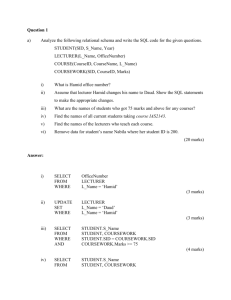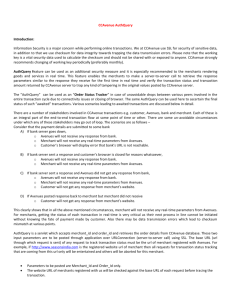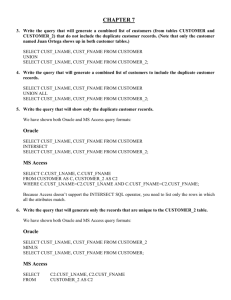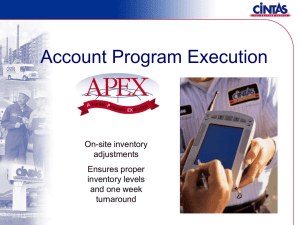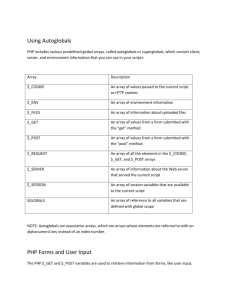Answers to homework
advertisement
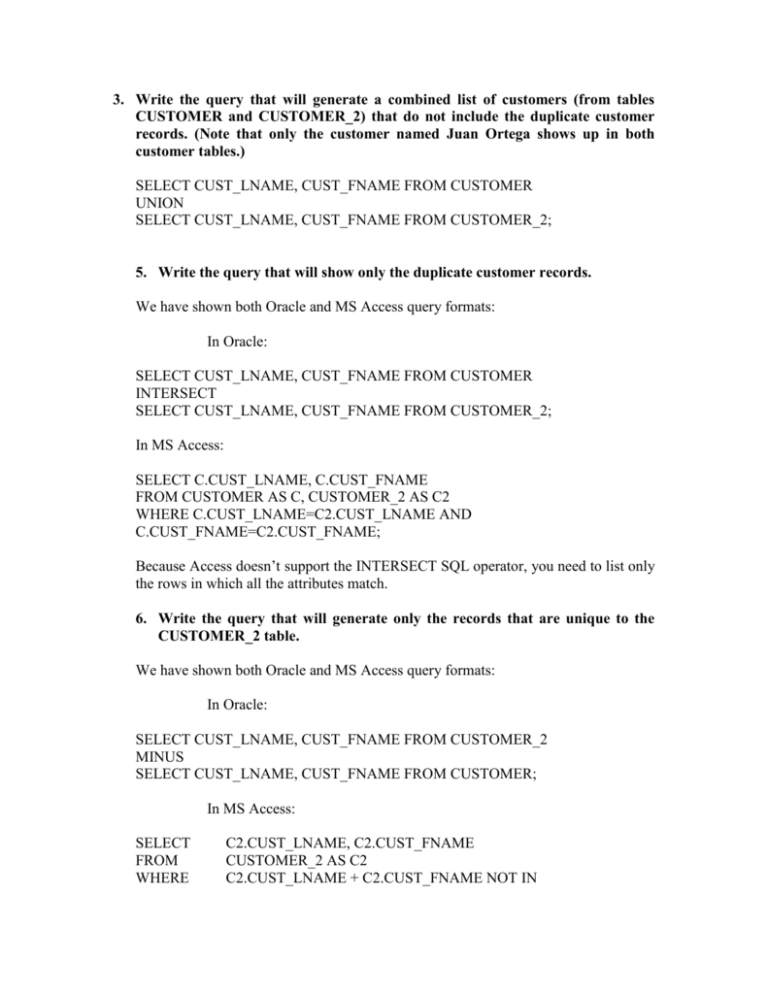
3. Write the query that will generate a combined list of customers (from tables CUSTOMER and CUSTOMER_2) that do not include the duplicate customer records. (Note that only the customer named Juan Ortega shows up in both customer tables.) SELECT CUST_LNAME, CUST_FNAME FROM CUSTOMER UNION SELECT CUST_LNAME, CUST_FNAME FROM CUSTOMER_2; 5. Write the query that will show only the duplicate customer records. We have shown both Oracle and MS Access query formats: In Oracle: SELECT CUST_LNAME, CUST_FNAME FROM CUSTOMER INTERSECT SELECT CUST_LNAME, CUST_FNAME FROM CUSTOMER_2; In MS Access: SELECT C.CUST_LNAME, C.CUST_FNAME FROM CUSTOMER AS C, CUSTOMER_2 AS C2 WHERE C.CUST_LNAME=C2.CUST_LNAME AND C.CUST_FNAME=C2.CUST_FNAME; Because Access doesn’t support the INTERSECT SQL operator, you need to list only the rows in which all the attributes match. 6. Write the query that will generate only the records that are unique to the CUSTOMER_2 table. We have shown both Oracle and MS Access query formats: In Oracle: SELECT CUST_LNAME, CUST_FNAME FROM CUSTOMER_2 MINUS SELECT CUST_LNAME, CUST_FNAME FROM CUSTOMER; In MS Access: SELECT FROM WHERE C2.CUST_LNAME, C2.CUST_FNAME CUSTOMER_2 AS C2 C2.CUST_LNAME + C2.CUST_FNAME NOT IN (SELECT C1.CUST_LNAME + C1.CUST_FNAME FROM CUSTOMER C1); Because Access doesn’t support the MINUS SQL operator, you need to list only the rows that are in CUSTOMER_2 that do not have a matching row in CUSTOMER. 7. Write the query to show the invoice number, the customer number, the customer name, the invoice date, and the invoice amount for all customers with a customer balance of $1,000 or more. This command will run in Oracle and in MS Access: SELECT INV_NUM, CUSTOMER.CUST_NUM, CUST_LNAME, CUST_FNAME, INV_DATE, INV_AMOUNT FROM INVOICE INNER JOIN CUSTOMER ON INVOICE.CUST_NUM=CUSTOMER.CUST_NUM WHERE CUST_BALANCE>=1000; 8. Write the query that will show the invoice number, the invoice amount, the average invoice amount, and the difference between the average invoice amount and the actual invoice amount. There are at least two ways to do this query. SELECT INV_NUM, AVG_INV, (INV_AMOUNT - AVG_INV) AS DIFF FROM INVOICE, (SELECT AVG(INV_AMOUNT) AS AVG_INV FROM INVOICE) GROUP BY INV_NUM, AVG_INV, INV_AMOUNT- AVG_INV Another way to write this query is: SELECT INV_NUM, INV_AMOUNT, (SELECT AVG(INV_AMOUNT) FROM INVOICE) AS AVG_INV, (INV_AMOUNT-(SELECT AVG(INV_AMOUNT) FROM INVOICE)) AS DIFF FROM INVOICE GROUP BY INV_NUM, INV_AMOUNT; The preceding code examples will run in both Oracle and MS Access. 10. Modify the CUSTOMER table to included two new attributes: CUST_DOB and CUST_AGE. Customer 1000 was born on March 15, 1979, and customer 1001 was born on December 22, 1988. In Oracle: ALTER TABLE CUSTOMER ADD (CUST_DOB DATE) ADD (CUST_AGE NUMBER); The SQL code required to enter the date values is: UPDATE CUSTOMER SET CUST_DOB = ’15-MAR-1979’ WHERE CUST_NUM = 1000; UPDATE CUSTOMER SET CUST_DOB = ‘2-DEC-1988’ WHERE CUST_NUM = 1001; 11. Assuming you completed problem 10, write the query that will list the names and ages of your customers. In Oracle: SELECT CUST_LNAME, CUST_FNAME, ROUND((SYSDATECUST_DOB)/365,0) AS AGE FROM CUSTOMER; In MS Access: SELECT CUST_LNAME, CUST_FNAME, ROUND((DATE()CUST_DOB)/365,0) AS AGE FROM CUSTOMER; 13. Write the query that will list the average age of your customers. (Assume that the CUSTOMER table has been modified to include the CUST_DOB and the derived CUST_AGE attribute.) SELECT AVG(CUST_AGE) FROM CUSTOMER; 14. Write the trigger to update the CUST_BALANCE in the CUSTOMER table when a new invoice record is entered. (Assume that the sale is a credit sale.) Test the trigger using the following new INVOICE record: 8005, 1001, ’27-APR-12’, 225.40 Name the trigger trg_updatecustbalance. CREATE OR REPLACE TRIGGER TRG_UPDATECUSTBALANCE AFTER INSERT ON INVOICE FOR EACH ROW BEGIN UPDATE CUSTOMER SET CUST_BALANCE = CUST_BALANCE + :NEW.INV_AMOUNT WHERE CUST_NUM = :NEW.CUST_NUM; END; To test the trigger you do the following: SELECT * FROM CUSTOMER; INSERT INTO INVOICE VALUES (8005,1001,’27-APR-12’,225.40); SELECT * FROM CUSTOMER; MS SQL SERVER SOLUTION create trigger trg_update_custbal on invoice after insert as update customer set customer.cust_balance= customer.cust_balance+ (select inv_amount from inserted) where customer.cust_num = (select cust_num from inserted); TO TEST select * from CUSTOMER; select * from INVOICE; insert into INVOICE values (8005,1001, '2013-03-01', 190); select * from CUSTOMER; select * from INVOICE; 15. Write a procedure to add a new customer to the CUSTOMER table. Use the following values in the new record: 1002, ‘Rauthor’, ‘Peter’, 0.00 Name the procedure prc_cust_add. Run a query to see if the record has been added. CREATE OR REPLACE PROCEDURE PRC_CUST_ADD (W_CN IN NUMBER, W_CLN IN VARCHAR, W_CFN IN VARCHAR, W_CBAL IN NUMBER) AS BEGIN INSERT INTO CUSTOMER (CUST_NUM, CUST_LNAME, CUST_FNAME, CUST_BALANCE) VALUES (W_CN, W_CLN, W_CFN, W_CBAL); END; To test the procedure: EXEC PRC_CUST_ADD(1002,’Rauthor’,’Peter’,0.00); SELECT * FROM CUSTOMER; MS SQL SERVER SOLUTION create PROCEDURE prv_cust_add @w_cn decimal(18,0), @w_cln varchar(20), @w_cfn varchar(20), @w_cbal decimal(18,0) as insert into customer (cust_num, cust_lname, cust_fname,cust_balance) values (@w_cn,@w_cln,@w_cfn,@w_cbal); TO TEST select * from CUSTOMER; exec prv_cust_add 1002,'Gold','Arthur',100; select * from CUSTOMER;
